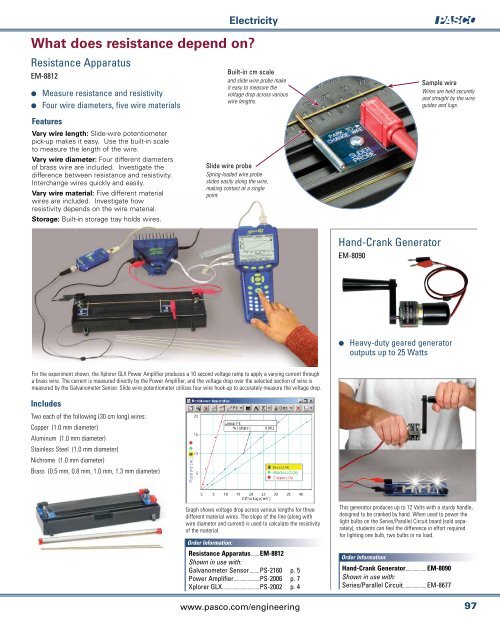Download catalog - Saint-Tech
Download catalog - Saint-Tech
Download catalog - Saint-Tech
You also want an ePaper? Increase the reach of your titles
YUMPU automatically turns print PDFs into web optimized ePapers that Google loves.
Electricity<br />
What does resistance depend on?<br />
Resistance.Apparatus<br />
EM-8812<br />
P .Measure.resistance.and.resistivity<br />
P .Four.wire.diameters,.five.wire.materials<br />
Features<br />
Vary wire length: Slide-wire potentiometer<br />
pick-up makes it easy. Use the built-in scale<br />
to measure the length of the wire.<br />
Vary wire diameter: Four different diameters<br />
of brass wire are included. Investigate the<br />
difference between resistance and resistivity.<br />
Interchange wires quickly and easily.<br />
Vary wire material: Five different material<br />
wires are included. Investigate how<br />
resistivity depends on the wire material.<br />
Storage: Built-in storage tray holds wires.<br />
Built-in.cm.scale<br />
and slide wire probe make<br />
it easy to measure the<br />
voltage drop across various<br />
wire lengths.<br />
Slide.wire.probe<br />
Spring-loaded wire probe<br />
slides easily along the wire,<br />
making contact at a single<br />
point.<br />
Sample.wire<br />
Wires are held securely<br />
and straight by the wire<br />
guides and lugs.<br />
Hand-Crank.Generator<br />
EM-8090<br />
P .Heavy-duty.geared.generator.<br />
outputs.up.to.25.Watts<br />
For the experiment shown, the Xplorer GLX Power Amplifier produces a 10 second voltage ramp to apply a varying current through<br />
a brass wire. The current is measured directly by the Power Amplifier, and the voltage drop over the selected section of wire is<br />
measured by the Galvanometer Sensor. Slide wire potentiometer utilizes four wire hook-up to accurately measure the voltage drop.<br />
Includes<br />
Two each of the following (30 cm long) wires:<br />
Copper (1.0 mm diameter)<br />
Aluminum (1.0 mm diameter)<br />
Stainless Steel (1.0 mm diameter)<br />
Nichrome (1.0 mm diameter)<br />
Brass (0.5 mm, 0.8 mm, 1.0 mm, 1.3 mm diameter)<br />
Graph shows voltage drop across various lengths for three<br />
different material wires. The slope of the line (along with<br />
wire diameter and current) is used to calculate the resistivity<br />
of the material.<br />
Order Information:<br />
Resistance Apparatus........EM-8812<br />
Shown in use with:<br />
Galvanometer.Sensor.........PS-2160.<br />
Power.Amplifier......................PS-2006.<br />
Xplorer.GLX................................PS-2002.<br />
p..5.<br />
p..7.<br />
p..4.<br />
www.pasco.com/engineering<br />
This generator produces up to 12 Volts with a sturdy handle,<br />
designed to be cranked by hand. When used to power the<br />
light bulbs on the Series/Parallel Circuit board (sold separately),<br />
students can feel the difference in effort required<br />
for lighting one bulb, two bulbs or no load.<br />
Order Information:<br />
Hand-Crank Generator..................EM-8090<br />
Shown in use with:<br />
Series/Parallel.Circuit.....................EM-8677.<br />
97
















